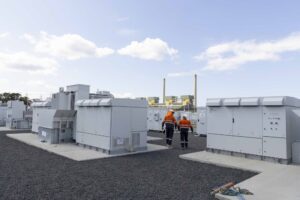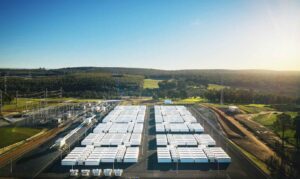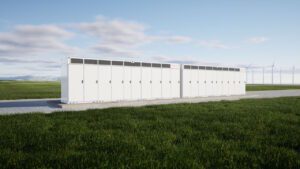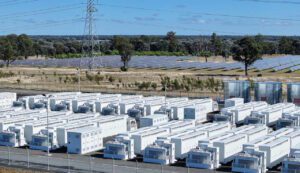Australia is riding the accelerating flow of the energy transition, switching from decades of relying on fossil-fuelled energy plants to renewable energy sources to meet decarbonisation objectives.
Supporting this scaling up of renewable energy is the re-emergence of pumped hydropower, a large-scale energy storage option assisting with demand management. It can play a defining role in Australia’s energy transition thanks to the balancing and system services provided to the energy grid.
We say re-emergence because pumped hydro technology is actually older than wind or solar generation, and battery storage – think Snowy Hydro in New South Wales which went into operation in 1972. Much further back, the Greeks used hydropower in the form of water wheels to grind wheat into flour more than 2,000 years ago.
Why the re-emergence? It fits the pattern of government support that wind and solar has received in past decades. The Australian government’s first Low Emissions Technology Statement, released in 2020, identified the importance of large-scale energy storage solutions such as pumped hydro for ensuring the security and reliability of Australia’s electricity grid.
This thinking paper examines the ‘how’ and ‘why’ of pumped hydro, and its re-emergence to be in the mix of renewable energy generation in the future.
The ‘how’ of pumped hydropower
The way pumped hydro works is relatively simple. It involves two connected reservoirs, one higher than the other, and a set of large turbines and generators. During peak demand from the power grid, the water is released from the upper reservoir through the turbines – continuously for 8 to 12 hours.
During times of off-peak demand, the turbines reverse pump the water back up to the upper reservoir. This recharges the system, making it prepped to commence the process again – providing a brilliant, closed loop, energy storage system (figure 1).

The ‘why’ of pumped hydropower
Australians want their energy on-demand, and individuals, as well as businesses, are increasingly expecting it to come from a renewable source. An essential attribute of our nation’s energy system is grid reliability – ensuring that energy generation matches demand in real-time.
The ‘why’ to the pumped hydro’s re-emergence in Australia is its ability to provide firming capacity to the grid. This means it can provide electricity over long time scales, with efficiency, especially during peak demand.
In particular, it supports the national energy grid by storing excess energy when wind or solar is generating, and filling in the gaps when they are not. This firming of renewable energy generation will help to support the country’s transition away from fossil fuels.
Pumped hydro projects currently in the pipeline in Australia include Snowy 2.0 in New South Wales, Kidston and Borumba Pumped Hydro Projects in Queensland, Tasmania’s Battery of the Nation and a number of other development projects.
The challenges to address
The energy decarbonisation and firming capacity benefits of pumped hydropower are extremely compelling reasons for projects to be developed. However, there are a number of real challenges that project proponents need to overcome in Australia, including:
- Large area requirements
- Environmental considerations
- Long development and construction cycle
- Business case and project financing
The three factors to bring projects to execution stage
Three key factors contribute to bringing pumped hydropower projects to the execution stage successfully:
1. Site selection and reference design
Front-end technical and financial feasibility is critical for pumped hydropower projects, with Aurecon able to work with clients to define the right site and the best design with the optimum mix of capacity and cost.
The critical success factors in site selection are access and transmission line routes. Deep storage is needed, with the required elevation between the two storage reservoirs to provide gravitational head. This quite often means that projects are in mountain ranges with complex access for construction and maintenance.
Finding the right site involves the analysis of both surface and underground concepts including lands and boundaries, any existing reservoirs, accessible waterways, visual amenity and environmental considerations. This is one point where cost management is critical as complex access can quickly escalate the cost of onsite inspections. Looking ahead, rapidly advancing remote technologies, such as drones with LIDAR capabilities, will ease access and cost pressures in challenging terrain.
Once a site is deemed viable from initial investigations, geotechnical investigations, stakeholder mapping and an environmental impact study will progress the reference design to determine a financial, technical, and commercial viability assessment. The proposed technology (such as whether the plant incorporates an above ground or underground power house), scale of facility, and environmental effects mitigation, will be included. This is the foundation of the overall business case for the project.
While this paper doesn’t examine the specific technical considerations of the technology, progression after the business case would be defining which speed design (fixed or variable). While the historical pumped hydropower constructions have used fixed speed units due to the National Electricity Market (NEM) requirements, there are specific ancillary services capabilities of fixed vs variable speed pumped hydro technology for the typical modes (figure 2) that a plant can operate at when called to provide the given service.
Such services would further support the roll-out of combined intermittent technologies such as wind and solar. Further, as a synchronous technology, fixed speed pumped hydropower can bring additional system security services that asynchronous storage technologies do not possess.
These reversible units come in two different forms: fixed speed and variable speed. The fixed-speed reversible units cannot optimise the uptake of power from the grid in pumping mode, which is important in a grid with rapid and frequent fluctuations characteristic of high levels of variable renewable energy. However, with a multi-unit arrangement in a power station, additional flexibility during the pumping cycle could be achieved at a premium.
Variable-speed reversible units provide greater efficiency and flexibility and provide different opportunities for grid support than fixed-speed units in pumping mode. However, should all the thermal plants be retired as the energy market transforms, the lack of synchronous machines could become a major issue where rotating inertia becomes scarce.
Asynchronous (variable-speed) machines rely on their power electronic controls to provide inertia. While this can be artificially enhanced relative to synchronous machines, it relies on externally provided system strength which may also be lacking in the absence of thermal units.

2. Market analysis and business case
The market analysis begins with need. This is the energy market demand that will determine reservoir size and storage capacity, together with the continuous volume required (the storage discharge duration) that will provide sustainable generation to the energy grid.
The technical and commercial assessment determines the market value of a project based upon the five-minute settlement contracting opportunities in the wholesale market (the price signals that incentivise generators and large energy users to respond to changes in supply and demand).
From these assessments, the potential commercial outcomes, risks and revenue earning opportunities of a project can be delivered as a cost model for consideration by the proponent (covering construction, operation and maintenance).
Under the current licensing process, obtaining a new project licence to construct may take between three and five years. This length of process attracts significant cost before returns are gained, detracting some potential investors. Going forward, assets owners could potentially pair a hydropower project with existing renewable energy portfolios to achieve financial viability.
Investment in pumped hydropower is a long-term proposition, with most of the sites under development in Australia expected to take at least three or four years to build. However, the typical design life of a plant is at least 50 years, with an operating life that greatly exceeds this in practice. This is significantly greater than the operating life of every other generation or storage technology currently available.
The Australian government is now making funding available to support targeted investments in the technology and help realise the significant potential that pumped hydropower has in delivering additional energy generation and much needed energy storage to the National Electricity Market.
Could the introduction of a capacity market help underpin the construction of the energy storage capacity needed to facilitate Australia’s transition to renewable energy? A capacity market may provide payments to dispatchable generators in return for ensuring their capacity is available in case of a generation shortfall, and be designed to ensure there is enough dispatchable capacity in the market.
Pumped hydropower plants are well placed to provide a range of the additional services contemplated in the Energy Security Board’s ‘Post 2025 Market Design’ program, including system strength, operating reserve, and synchronous inertia. The capacity mechanism proposed by the Energy Security Board could pay energy providers to bolster the stability of the grid and attract investment to build new sources of renewable energy.
Designed well, the capacity mechanism and payments may underpin the development of new long-duration energy storage projects such as pumped hydro energy storage to enable a swift, stable and orderly transition to a net zero carbon emissions future.
Pumped hydro assets involve both generation and transmission, making the business models more complex. Long-term policies, regulatory simplification and increased visibility can help utilities and investors better understand the benefits and their value that pumped hydropower storage provides. A variety of market designs and revenue schemes have been implemented successfully globally. Summarised in figure 3 are some of the different approaches Aurecon has seen implemented.

3. Delivering a safe and viable design
If the early assessments stack up, it then comes down to design and delivery. Each project has multiple design stages due to the demanding and stringent standards, and cost controls, required for these mega-projects.
The challenge for Australia is that due to the limited number of pumped hydropower projects delivered in the last 40 years, there is a design and construction experience and skills gap. We’ll see rapid advancement in skills as proposed projects begin to be developed further.
This will involve multidisciplinary teams and the application of foundational design and engineering principles. There are many critical factors in the design process; safety in design, technology, constructability, grid connection, site configuration, speed solutions and flexibility, and governance.
Procurement and contracting
Thinking about the procurement and contracting approach is critical in the early stages of project development as pumped hydropower projects will be demanding for contractors due to their size, complexity and commonly, remote location.
Selecting a collaborative procurement model, and agreeing the delivery strategy in the early stages, is the key to success on these projects. Each is unique, so information shared with stakeholders and suppliers through a collaborative procurement model will assist with design and construction innovation.
This approach also reduces procurement risks; availability of capable contractors, and design and supply chain management from the original equipment manufacturer suppliers for the main turbine units and auxiliary plant (due to long lead times). The two most common procurement models are Early Contractor Involvement (ECI) and Early Tenderer Involvement (ETI) and each has three principal stages:
- Expression of interest (general capability is used to shortlist)
- Request for proposal (detailed outline plans, rates and fees used to select for the ECI/ETI phase)
- Collaborative ECI/ETI phase with the tenderers to analyse the project requirements and prepare final tender responses
A safe design is critical
Underground excavation support and stabilisation needs to protect construction workers and then prevent collapse or tunnel cave-in during operation. Reservoir stability is also just as crucial to hold the required volume of water for reservoir storage without sink holes or landslides due to fluctuating drawdown stresses and seepage issues associated with an operating pumped hydropower energy storage reservoir.
One aspect that has changed significantly since Snowy Hydro went into operation is the advancement of digital technologies to inform design scenarios.
Failure scenarios can be digitally modelled to determine the required stability and safety requirements for the final design. Whilst a physical hydraulic model is still beneficial, there are now advancements in digital modelling that simulate turbulent water behaviour in the intake to inform the conveyance design.
Turbine load rejection is one of the most dangerous transients in pumped hydropower plants and now with the aid of transient analysis software and digital engineering can simulate scenarios to provide designers with confidence that appropriate structural strength requirements can be applied, and that operational features will keep operational personnel and plant safe.
In addition to safe design, today’s project proponents are minimising impacts by focusing on new project sites where proposed construction has minimal environmental impacts.
———————————————————————————————————————-
Phil Scott is hydropower technical director at Aurecon. Aurecon is a designer of pumped hydropower projects, and also assists project proponents to prioritise investments through market analysis, and technical, commercial and financial assessments. It also provides construction oversight into commercial operations.








